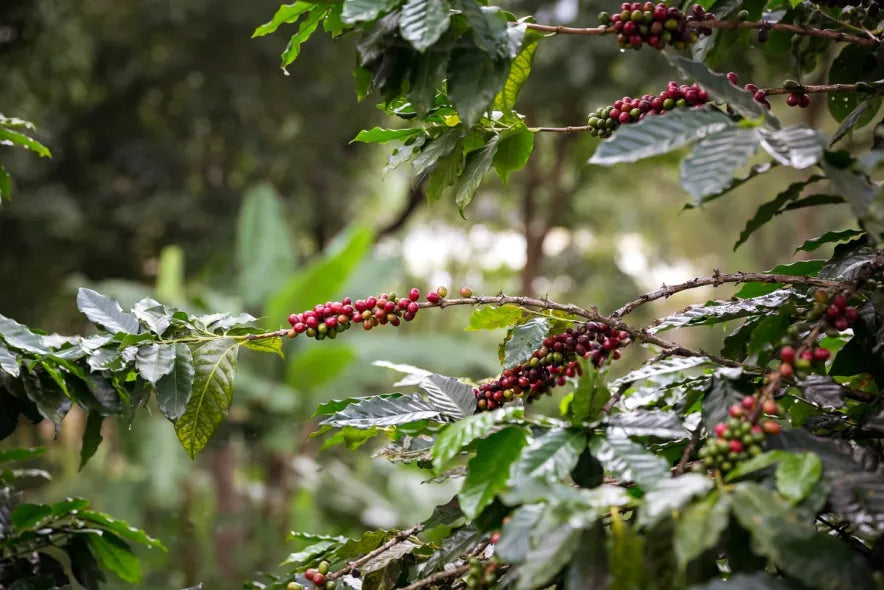
Plants 101
How to Care for a Coffee Plant
Learn how to create the best growing conditions for a Coffee plant.

Coffee plants, also known as Coffea arabica, are a popular indoor plant that is native to Ethiopia. They are prized for their glossy leaves and delicate white flowers, which eventually give way to coffee berries. Coffee plants are also known as 'Arabica Coffee Plants', due to their species name, and are part of the Rubiaceae family. Today, coffee cultivation has expanded to various regions worldwide, including Central and South America, Asia, and parts of Africa.
Types of Coffee Plants
There are many different varieties of Coffee Plants, including Coffea arabica and Coffea robusta which are the two primary species of coffee plants cultivated for consumption.
Arabica, known for its superior quality, represents about 70% of global coffee production. It thrives in higher altitudes, with a preference for cooler temperatures and more shade. Arabica beans have a delicate and complex flavor profile, often characterized by fruity and floral notes.
On the other hand, Robusta is hardier and can withstand lower altitudes and warmer climates. It is more disease-resistant and has a higher caffeine content. Robusta beans are often considered more bitter and have a stronger, earthier taste. They are commonly used in blends, instant coffees, and espresso due to their robust flavor and crema production.

Sunlight
Coffee plants prefer bright, indirect light, but can tolerate morning direct sun. Indoors, it's best to place them in an East or West-facing window, but a South window can work if you diffuse the afternoon direct sun.
Avoid placing your Coffee plant in a North window since it only provides about a low-moderate indirect light for plants. Direct sunlight can scorch their leaves, while too little light can cause them to become leggy and spindly. If your coffee plant is not getting enough light, it may stop growing or drop its leaves.
Not sure if your space will provide enough light? Consider measuring light to ensure your Coffee plant will receive enough. If you find your space doesn't provide enough light then consider installing a grow light to keep over the plant for 8-12 hours a day.
Water
Coffee plants like to be kept moist but not wet, so it's important to water them regularly but not overwater. Water the plant thoroughly once about half the soil has dried out, and be sure to use a pot with drainage holes to prevent water from accumulating in the soil. You can utilize a moisture meter to help you properly gauage soil moisture and avoid overwatering!
Avoid getting water on the leaves, as this can cause them to develop brown spots or fungal infections.
Humidity
Coffee plants prefer high humidity, so it's important to keep them in a room with a humidifier or group them together with other plants to form a microclimate. Dry air can cause the leaves to become dry and crispy.
Not sure if humidity is high enough? You can measure the level of humidity with a hygrometer or LTH meter.
Temperature
Coffee plants prefer temperatures between 60°F and 75°F (16°C to 24°C), so it's important to keep them in a room that is not too hot or too cold. Avoid placing them near drafts, air conditioning vents, or radiators, as sudden temperature changes can stress the plant and cause its leaves to drop.
Soil
Coffee plants prefer a well-draining potting mix that is rich in organic matter like compost or worm castings. Be sure to repot your coffee plant every year or two to ensure that it has enough room to grow and to refresh the soil.
Will my Coffee plant produce beans?
Coffee plants typically take around three to five years to produce their first significant harvest of coffee berries or beans. The time it takes for coffee plants to bear fruit depends on several factors, including the variety of coffee, growing conditions, and cultivation practices.
After the coffee plant flowers, it takes approximately nine months for the berries to ripen. However, the initial yield is usually small, and it may take several years for the plant to reach its full production potential.
It can be rare for Coffee plants to produce beans when grown as a houseplant, but patience and optimal care are crucial to make it possible. During the early years, plant parents need to nurture the plant to ensure healthy and consistent yields in the future.
Common Problems
Here are some common problems you may encounter when caring for a Coffee Plant:
SYMPTOM: Leaf drop, moist potting mix
CAUSE: Not enough light
SYMPTOM: Yellowing leaves, mushy blackened base
CAUSE: Overwatered
SYMPTOM: Wilting and curling leaves, dry potting mix
CAUSE: Underwatered
SYMPTOM: Brown tips and edges of leaves
CAUSE: Low humidity, or underwatering
Precautions
While Coffee Plants are generally safe to grow in the home, there are a few precautions you should take to ensure the health and safety of yourself and others:
- Caffeine: Coffee Plants produce caffeine, so it's important to keep them out of reach of children and pets who may try to eat the berries or leaves. Ingesting caffeine can cause nausea, vomiting, and other symptoms.
- Poisonous: While the berries of the Coffee Plant are safe to eat once they are roasted, the raw berries and leaves can be toxic if ingested. If you have pets or young children in the house, it's important to keep the plant out of reach.
By following these tips and taking the necessary precautions, you can enjoy the beauty and benefits of a Coffee Plant in your home for years to come.

Words By The Sill
Empowering all people to be plant people—a collection of articles from The Sill's team of plant experts across a variety of plant care topics to inspire confidence in the next generation of plant parents. Welcome to Plant Parenthood™.
Do Some Plant Shopping